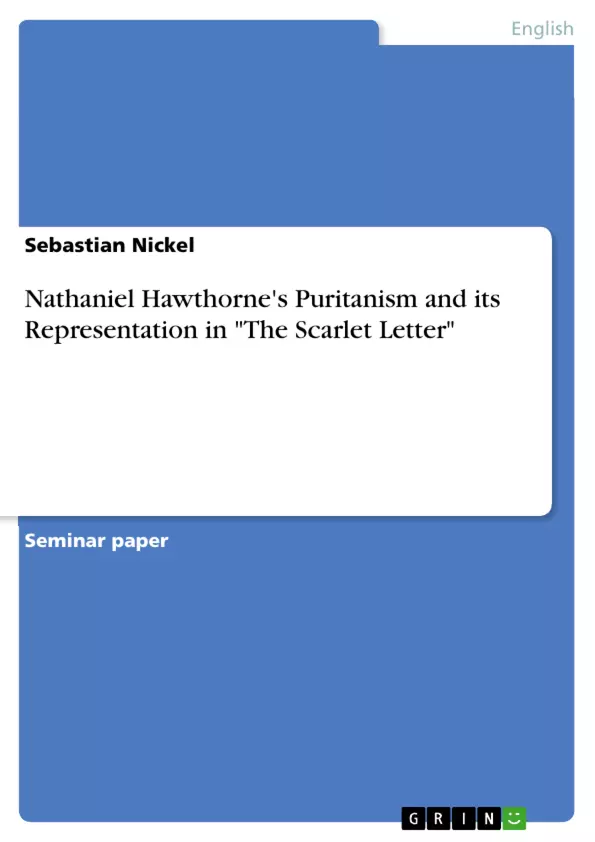Nathaniel Hawthorne is considered as one of the most significant American novelist of romantisism of the early 19th century. The interplay between contrasting and ambigious literary motifs can be taken as typical for the era of romantisism as well as for Hawthorne’s personal style of writing. In his novels he devoted himself in exploring moral and the social issues of the American society and its roots in the Puritan heritage. Thereby, he often thematised his own deep bonds with his Puritan ancestors and created story plots that both highlighted their weaknesses and their strengths. Whereas Hawthorne himself openly showed admiration for the strengths and determination of his Puritan ancestors, he also adresses his own negative concerns for their rigid and oppressive rules of living.
"The Scarlet Letter" from 1850, as a text book expample of his great literary works, shows Hawthorne’s attitude towards Puritans from the Massachusetts Bay Colonies in his portrayal of characters, his plot, and the themes of his story. This ten-page thesis paper attempts to probe into Hawthorne’s contradictory religious thoughts reflected in "The Scarlet Letter". In course of this, I vindicate the point of view that Hawthorne illustrates Puritanism as contradictory. Furthermore I claim that his critique on Puritanism is partly contradictory as well. This contradictoriness of his critique is also often accompanied by an ambiguity of his literary illustrations.
The 2nd and 3rd chapter of this paper will shortly expose the major characteristics of Puritanism and Hawthorne’s personal relation to it. The major focus is put on elaborating the contradictions of the depicted Puritanism and Hawthorne’s attitude to it in the 4th chapter.
Table of Contents
- Introduction
- A brief profile of Puritanism
- Hawthorne's Puritanism
- Contradictions of and around Puritanism in "The Scarlet Letter"
- Conclusion
Objectives and Key Themes
This thesis paper examines the contradictory religious thoughts of Nathaniel Hawthorne as reflected in his novel "The Scarlet Letter". The paper aims to demonstrate how Hawthorne portrays Puritanism as a complex and contradictory system, while simultaneously highlighting the inherent ambiguity of his own critique.
- Hawthorne's representation of Puritanism in "The Scarlet Letter"
- The inherent contradictions within Puritanism
- The influence of Hawthorne's personal background and the legacy of his Puritan ancestors
- The impact of Puritanism on the social and moral fabric of the American society
- The complex relationship between Hawthorne's admiration and criticism of Puritanism
Chapter Summaries
- The introduction contextualizes Hawthorne's work within the romanticism movement and highlights his focus on the moral and social issues of American society. It introduces the concept of Puritanism as a key element in his writing and sets the stage for examining his contradictory views on this historical and religious movement.
- The second chapter provides a concise overview of Puritanism, outlining its origins in Calvinist doctrine and its establishment as a dominant force in early American colonies. It explores the key tenets of Puritan belief, including predestination, the inherent sinfulness of humankind, and the importance of strict adherence to biblical principles.
- The third chapter delves into Hawthorne's personal connection to Puritanism. It highlights the influence of his family history, particularly the role of his ancestor in the Salem witchcraft trials, and analyzes how this personal legacy shaped his perspectives on the Puritan code. The chapter also explores the broader societal impact of Puritanism in 19th-century New England.
Keywords
This preview explores the key themes and concepts of Nathaniel Hawthorne's "The Scarlet Letter". The primary terms and concepts include Puritanism, Calvinism, predestination, sin, moral ambiguity, social criticism, romanticism, and the interplay between the past and the present in shaping American identity.
- Quote paper
- Sebastian Nickel (Author), 2017, Nathaniel Hawthorne's Puritanism and its Representation in "The Scarlet Letter", Munich, GRIN Verlag, https://www.grin.com/document/444883



